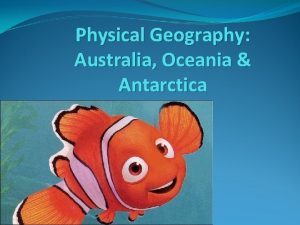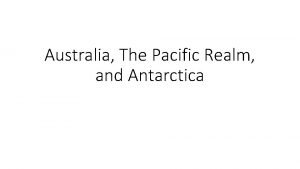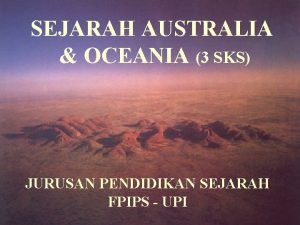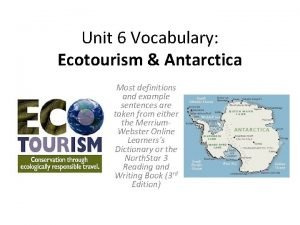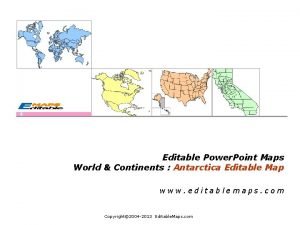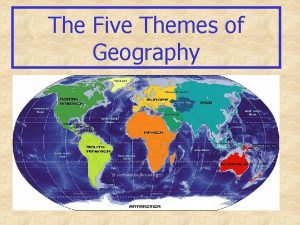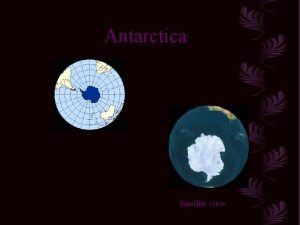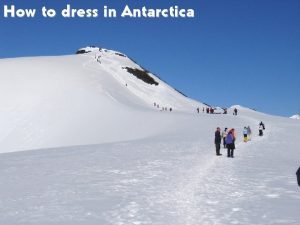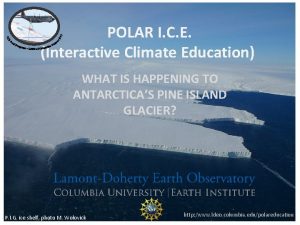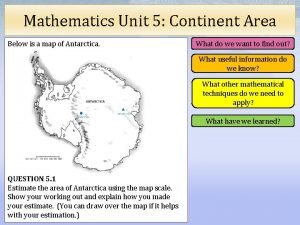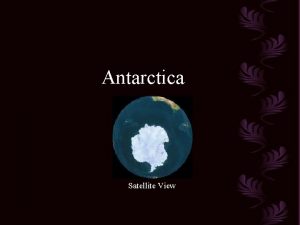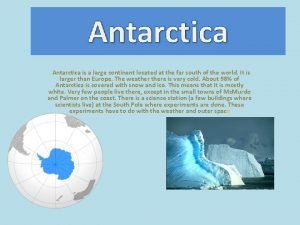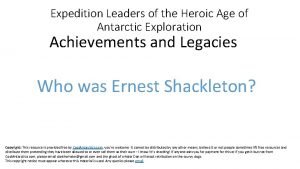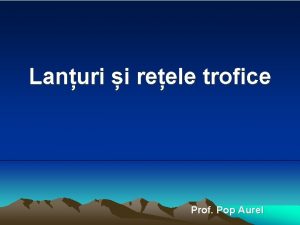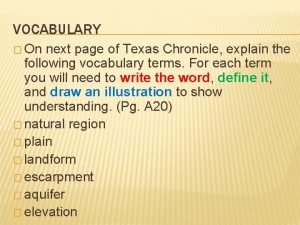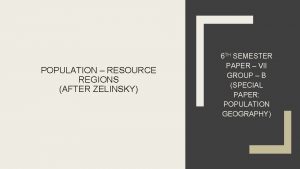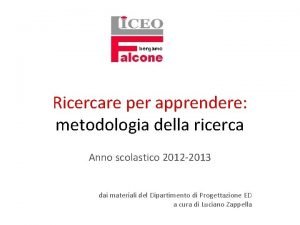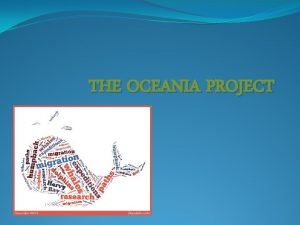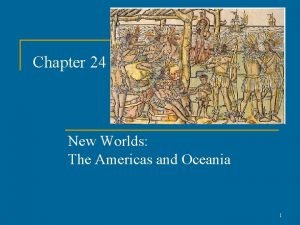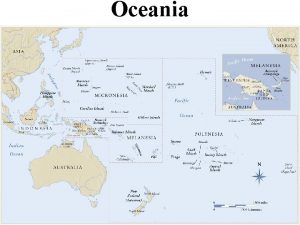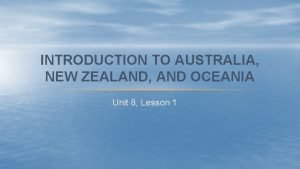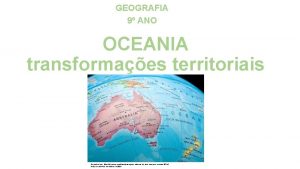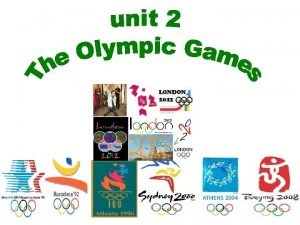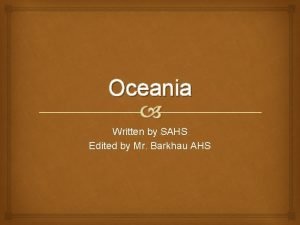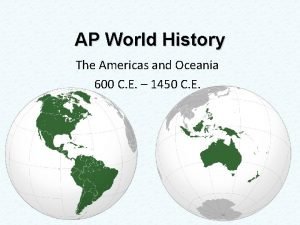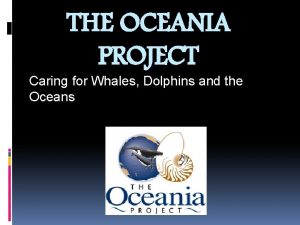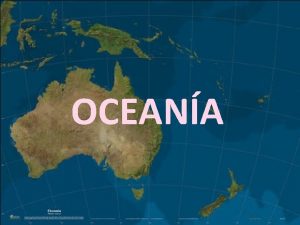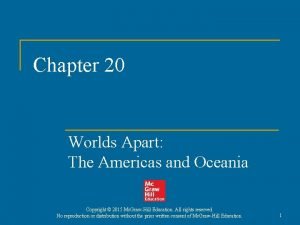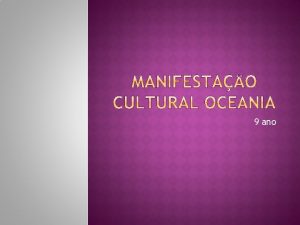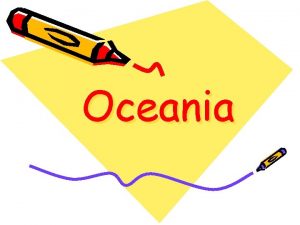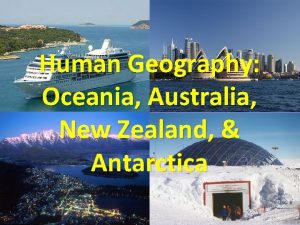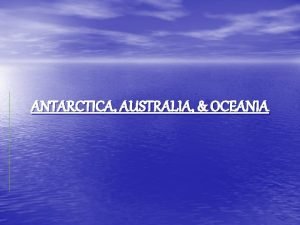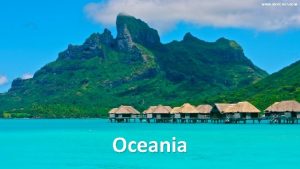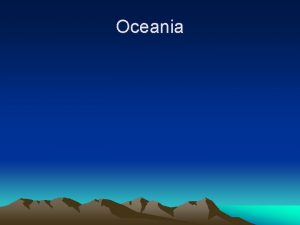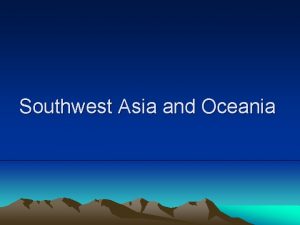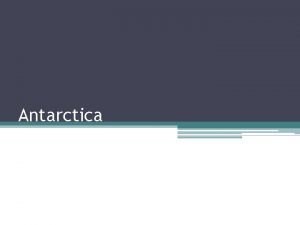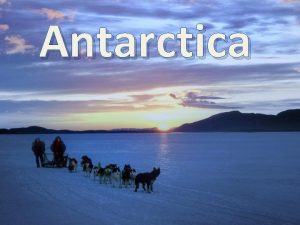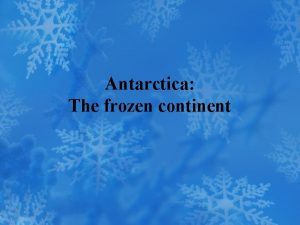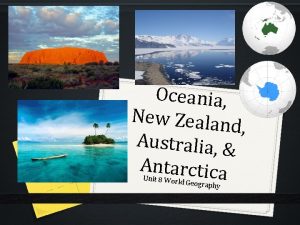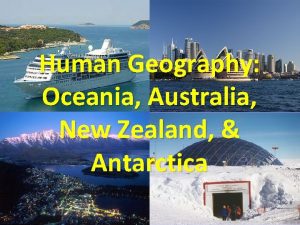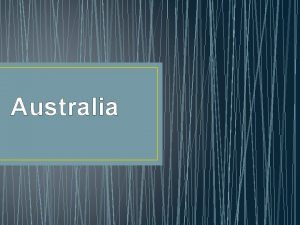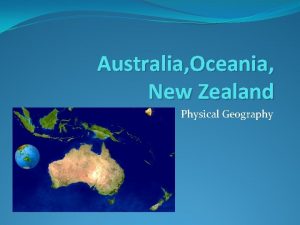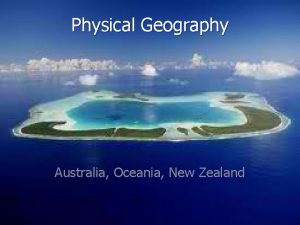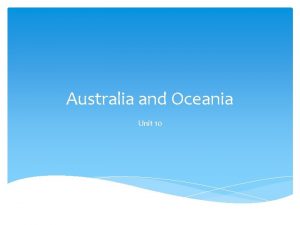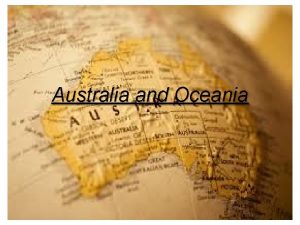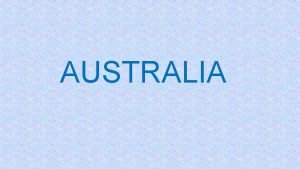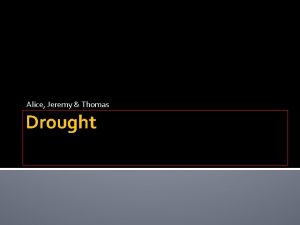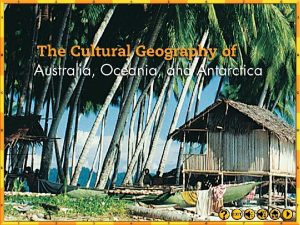Australia Oceania Antarctica Population of the region only












































- Slides: 44

Australia, Oceania, & Antarctica • Population of the region: only 32 million people (half in Australia, none in Antarctica!) • Culture is a mix of European, traditional Pacific, & Asian – Christianity is most common religion, but traditional beliefs are intermixed • A wide range of climates, ecosystems, & landforms

Chapter 24: Australia & New Zealand Pg. 729 -762

Australia • A continent AND a country • Under-populated

Physical Geography of Australia • Australia is divided into 3 regions: – Western Plateau – Central Lowlands – Eastern Highlands • Climate: – Tropical in the North, but subtropical in the rest – Desert in the central and west with bands of semiarid steppes to the north, east, & south

The Outback • Arid plains & plateaus in the central & western regions of Australia • Eastern mountains block moisture from interior – Ayers Rock (called “Uluru” by aborigines) is a monolith (single standing stone) in the Central Lowlands

The Great Barrier Reef • World’s largest coral reef – Along the northeast coast of Australia

New Zealand • 2 volcanic islands in the Ring of Fire – North Island: volcanoes, geysers, & hot springs – South Island: mountains • Climates range from subantarctic in the south to subtropical in the north.

Unique Wildlife in Australia • 150 species of marsupials (mammals with pouches): Kangaroos, koalas (in eucalyptus trees), & platypuses • Dangerous crocodiles, poisonous cobras & spiders • Dingoes – domesticated dogs (some run wild)

History of the “Aussies” • Aborigines – Nomadic hunter-gatherers that crossed a land bridge between Southeast Asia & Australia – They were isolated in Australia until 1770 when Captain James Cook arrived from Great Britain to start a settlement

History of the “Kiwis” • Maori people arrived in New Zealand by canoe in AD 900 – Tikanga – traditional Maori customs - Believe all life in the universe is connected (kapa haka performance) – Warring tribes fought over farmland & fishing territory • 1769 – British settled there

Australia as a British Colony • Served as a prison for 162, 000 British criminals • More settlers came later for cheap land & gold, pushing Aborigines off their land spreading disease to their populations – Only about 460, 000 left today (2% of Australia’s population)

Independence for Australia & New Zealand • Became self-governing dominions of the British Empire in the early 1900 s, but achieved full independence after World War II – Both set up federal republics with written constitutions

Aborigines & the Land • Believe their ancestors long ago created the Earth, so it’s their responsibility to protect it • Take only what they need so the delicate landscape is preserved • Boomerangs – Used to stun prey • Didgeridoo – Aboriginal instrument

Europeans & the Australia’s Land • Wanted to make money off the land – Mine for gold, coal, iron ore, copper, zinc, uranium, lead, bauxite, oil – Huge stations (ranches) in the “bush” (rural areas in the outback) • Sheep in the south • Cattle in the hotter north & center

Introduced Species • Page 756 -759 • What species exist in Australia that are nonnative species? • What damage has been caused by these invasive species?

Life in Australia & New Zealand • Australia & New Zealand are multicultural lands with diverse human populations. • Aboriginal & Maori cultures have experienced revivals in Australia and New Zealand • Most Australians & New Zealanders live in urban areas. • Religions: Christianity, Buddhism, Islam, Hinduism, & native religions

Population Distribution in Australia • 90% of the people live within 100 miles of the ocean – Why?

Australia’s Cities • Perth – 1, 400 miles from the nearest city • Sydney – Oldest & largest city – Excellent harbor – Sydney Opera House

Australia’s Cities • Melbourne – 2 nd largest city – Lots of factories • Canberra – Capital city that’s 100 miles inland • Darwin – Tropical climate, but close to deserts – Cyclones (hurricanes) – Bombed by Japan during WWII

Australia’s Economy • Resource extraction, agriculture, & tourism – Relies on exports of its natural resources, which include coal, iron ore, & gold • Periodic droughts threaten animals & crops • What is life like as a rancher in Australia?

New Zealand’s Economy • Agriculture, Dairy cattle & sheep (more sheep than people in New Zealand!) – Coal, iron ore, & gold – Geothermal energy – Kiwifruit • City of Auckland – main port

Current Issues • Aborigines and Maoris have been petitioning their governments for more rights • Australia & New Zealand have low birthrates and death rates, which has created a need for more workers to support the older population. – Increased immigration from Asia has been filling jobs

Chapter 25 – Oceania 10, 000 islands spread over 3. 3 million square miles Pg. 763 -786

3 Regions of the Pacific • Micronesia • Melanesia • Polynesia – Were all settled at different times

Pacific Islands • 3 types of islands: – “High islands” - Volcanic islands w/ mountains, waterfalls & fertile soil • Tahiti , Fiji, Hawaii, & Samoa – “Low islands” – flat, sandy islands with poor soil, some with atolls (a coral reef island surrounding a lagoon) • Marshall Islands & Kiribati – Continental islands – formed by tectonic movements – were once part of a continent • New Guinea & Solomon Islands • Most have tropical climates with wet/dry seasons

History of the Pacific Islands • Settled by SE Asians by wayfinding in the 1500 s BC – Navigation using sun, stars, or ocean currents

Easter Island (Rapa Nui) • 1, 200 miles from the nearest Polynesian island • Famous for huge stone head statues made between AD 1400 -1600

European colonization began in the AD 1500 s • Used as bases to restock ships or mine resources • Many islands were taken over by Japan during WWII and witnessed bloody battles – Some islands were used for atomic bomb testing (Bikini Atoll, Mururoa Atoll), but that is banned today

Independence for Pacific Islands • Many islands fought for or negotiated for freedom after WWII • Today – a variety of governments but often still connected to Western powers – Kingdoms, democracies, traditional tribal groups – Trust territories – The United Nations has given governing authority to another country to help them – Possessions – owned and ruled by another country (i. e. French Polynesia)

Papua New Guinea • Eastern half of New Guinea (the rest belongs to Indonesia) • Diverse – 860 languages! – Use pidgin to communicate • Economy – mostly subsistence farming – Recently discovered large natural gas deposits and is gradually modernizing – Raises cash crops (coffee, cacao, coconuts, rubber, tea) – Mining – gold, copper

Daily Life in Oceania • Many islands have “westernized (clothes, hairstyles, Internet), ” but still practice cultural traditions (luaus, coming-of-age ceremonies, tattooing, wood carving) – Samoa – live in fales – traditional homes with no walls • Religion – mostly Christianity, but with traditional religious influence • Music & Dancing: Kiribati, Tahiti, & Samoa

Food of the Pacific Islands • Fish & pork • Yams & Taro (a tuber that’s mashed into a paste called poi) • Breadfruit – baked like a potato, but sweeter • Fruit – coconut, passionfruit, guava, mango

Pacific Islands’ Economies • Small and spread-out land area, so limited natural resources – Subsistence farming & fishing – coconuts, pineapples, bananas, skipjack, yellowfin tuna – Cash crops – rubber, coffee, sugar cane – Tourism – esp. resorts in Fiji & Tonga – Wind & solar power for local use

Economic Help From Foreign Countries • MIRAB economies – “Migration, Remittances, Aid, & Bureaucracy” • These island countries cannot support their populations without help from other countries • Remittance: foreign-earned wages sent back to families on the islands • American Samoa, Guam, & Wake Island depend heavily on the US economy and military bases for jobs.

The Future of Oceania… • Outmigration of young people (for jobs) • Weak economies, dependent on imports • Environmental issues – Climate change – rising ocean levels – Deforestation – Pollution – Typhoons, earthquakes, tsunamis, flooding – Declining fish population

Chapter 26: Antarctica Pg. 787 -806

Antarctica • 1/10 of the world’s land, at a high elevation, & covered with an ice sheet (thick layer of ice) • No permanent human settlements • Inhabited by penguins, lichens (algae & fungi), & seals, with fish, whales, krill, & plankton in the Southern Ocean

Climate of Antarctica • Ice reflects the sun’s rays, so it’s frigid – Ave temp: -71 F – Lowest temp ever: -128. 6 F • Strong, cold katabatic winds blow from the interior of Antarctica – up to 155 mph • Very dry – 2 -4 inches/year @ the South Pole – The world’s largest cold desert & driest continent

Challenges of traveling on Antarctica • Crevasses – cracks in the ice sheets – Dangerous for travelers!

Challenges of traveling to Antarctica • Ice Shelves ice sheets that hang out over the ocean • Pieces calve (break off) as icebergs

Challenges of traveling to Antarctica • The cold water surrounding Antarctica melts & freezes as the seasons change • Convergence zone – where cold & warm waters meet, causing severe storms

Exploring Antarctica • Discovered in 1820 s, but no one landed on it until 1895 • Roald Amundsen & Robert Scott led separate expeditions to be the first to the South Pole in 1911 • Several countries claimed parts of the territory out of national pride & possible minerals under the ice

What does the world use Antarctica for today? • Antarctic Treaty of 1959 – 45 countries agreed to peaceful use of the continent & sharing of scientific research – No military training – No nuclear waste dumping – No bomb testing

What does the world use Antarctica for today? • Scientific research – 11004400 researchers live there temporarily at 50 research stations – Ozone layer research – Remote sensing of what is below the ice sheets – Study evolution, continental drift & plate tectonics, & climate change • 6, 000 tourists travel there each year
 Australia oceania and antarctica
Australia oceania and antarctica Australia the pacific realm and antarctica
Australia the pacific realm and antarctica Sejarah australia dan oceania
Sejarah australia dan oceania Population density map australia
Population density map australia Satellite photos of antarctica
Satellite photos of antarctica The presence of coal in antarctica indicates that
The presence of coal in antarctica indicates that Antarctica synonym
Antarctica synonym Antarctica outline map
Antarctica outline map Invendável e imprestável
Invendável e imprestável Antarctica is in which hemisphere
Antarctica is in which hemisphere Cool antarctica.com
Cool antarctica.com Antarctica satellite view
Antarctica satellite view How to dress for antarctica
How to dress for antarctica Map of antarctica
Map of antarctica Estimate the area of antarctica using the map scale
Estimate the area of antarctica using the map scale Satellite view of antarctica
Satellite view of antarctica Where is antarctica located
Where is antarctica located Heroic age of antarctic exploration
Heroic age of antarctic exploration Verigile trofice
Verigile trofice Population ecology section 1 population dynamics
Population ecology section 1 population dynamics Chapter 4 section 1 population dynamics study guide
Chapter 4 section 1 population dynamics study guide Chapter 4 population ecology worksheet answer key
Chapter 4 population ecology worksheet answer key Population ecology section 1 population dynamics
Population ecology section 1 population dynamics Mountains and basins region population
Mountains and basins region population Population resource region
Population resource region Ungaretti mappa concettuale
Ungaretti mappa concettuale Why are parents in oceania often afraid
Why are parents in oceania often afraid London, airstrip one, oceania
London, airstrip one, oceania Oceania project
Oceania project Chapter 24 new worlds the americas and oceania
Chapter 24 new worlds the americas and oceania Physical features of oceania
Physical features of oceania Oceania 1
Oceania 1 Lesson 1 an introduction to oceania
Lesson 1 an introduction to oceania Slides sobre a oceania 9 ano
Slides sobre a oceania 9 ano Oceania
Oceania What is ocieana
What is ocieana New worlds the americas and oceania
New worlds the americas and oceania Oceania ap world history
Oceania ap world history The oceania project
The oceania project Continentes de asia
Continentes de asia Colonial encounters in asia africa and oceania
Colonial encounters in asia africa and oceania Que es un continente insular
Que es un continente insular Oceania history and culture
Oceania history and culture Chapter 20 worlds apart the americas and oceania
Chapter 20 worlds apart the americas and oceania Danças típicas da oceania
Danças típicas da oceania
